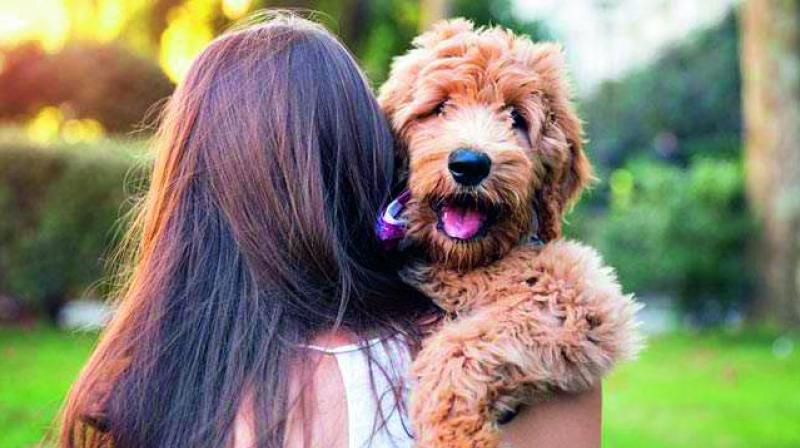Pet therapy: Dog is a child's best medicine

A Swedish study published in the Journal of Scientific Reports revealed that dog ownership is associated with a reduced risk of cardiovascular disease, among other benefits, and as a consequence dog owners live longer. This may come as a revelation, but it has been long known that dogs improve the immunity of those co-habiting with them (particularly children). Having grown up around dogs, I’ve always considered myself lucky. After becoming a doctor, I realised the various health benefits of sharing your childhood with a pet. Once I became a certified dog trainer and behaviourist, I realised the amazing role the pet plays in inculcating empathy, compassion and responsibility in a child. Finally, as a mother of a five-year-old daughter, I cannot overstate the fact that pets are truly a child’s best friend. Here are some reasons to let fur fly in the house:
Pets protect
As a behaviourist, I frequently get calls from expecting mothers who are concerned about hygiene levels of having a pet around a newborn. They are so anxious about the baby that they are willing to re-home their pets.
Contrary to popular perception, there is strong scientific evidence to believe that the dirt (antigens) brought by your pet into the house actually helps regulate the maturation of the child’s immune system and protects the child from developing asthma and a variety of allergic diseases.
The “hygiene hypothesis” was first formulated in 1989 by an epidemiologist, Dr Strachan, who reported an inverse relationship between family size and development of atopic disorders, and proposed that a lower incidence of infection in early childhood, transmitted by unhygienic contact with older siblings or acquired pre-natally could be a cause for the rise in allergic diseases.
Considering the shrinking size of families, the world is experiencing a rise in the incidence of allergic disorders. And this is where pets come in. They could act as an alternative to a sibling and ensure that the growing child has adequate exposure to “dirt” to help develop its immune system.
Pets promote learning
Parents and relatives of young children often believe that pets are a distraction. However, I find my daughter, who is usually reluctant to read, now reading aloud to our dog as she pets him, shows him pictures, and asks him questions. This seemed surprising till I read the book The World of Children and Their Companion Animals.
The book states that all children can benefit from the presence of a non-judgemental pal with paws. Research shows reduced stress levels and found that kids were most relaxed around the animal, not humans. This has been implemented across the world by bringing therapy animals (mostly dogs) into schools to help developmentally-challenged kids learn.
Pets build family bonds
A pet is often the focus of activities that families do together. Everyone takes the dog for a walk, which increases physical activity, or takes turns in grooming and feeding him, or gets down on the floor and plays with him. There are even benefits from simply watching a cat chase her tail or a fish swim in his tank. Spending time like this offers the wonderful potential of slowing down the hectic pace of modern life. If someone asks what you’ve been doing, you might respond “nothing”. And in this era of overscheduled children and parents who are constantly on the go, “nothing” can be an important thing to do.
Further, pets reduce depression, anxiety, and social isolation thanks to the strong relations between the owner and the pet. Positive relationships show measurably higher oxytocin with lower cortisol and alpha-amylase levels. All the above are proven to reduce the risk of heart diseases.
Pets encourage nurturing
Dr Melson began studying the impact of pets in order to learn how human beings develop the ability to care for others. “Nurturing isn’t a quality that suddenly appears in adulthood when we need it,” she says. “And you don’t learn to nurture because you were nurtured as a child. People need a way to practise being caregivers when they’re young.”
In our modern world, there’s little opportunity for kids to provide for other living things aside from pets. “In many other countries, siblings look after one another, but in the US that’s not culturally acceptable,” Dr Melson says. “It’s actually illegal in many states to leave kids in the care of anyone who is under 16 years of age.”
So, how are the seeds of good parenting skills planted during childhood? Dr Melson believes one way is through pets. In her research, she tracked how much time kids over age three spent actively caring for their pets versus caring for or even playing with younger siblings. Over a 24-hour period, pet-owning kids spent 10.3 minutes in care-giving; those with younger siblings spent only 2.4 minutes.
“Nurturing animals is especially important for boys because taking care of an animal isn’t seen as a ‘girl’ thing like babysitting, playing house, or playing with dolls,” Dr Melson says. By age eight, girls are more likely to be involved than boys in baby care both inside and outside their homes, but when it comes to pet care, both genders remain equally involved.

